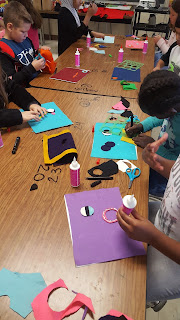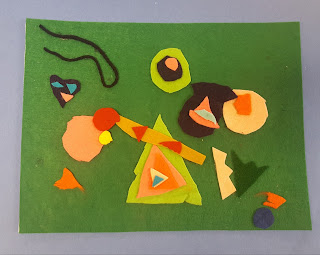As the author for the Stepping Stones column, I recently shared that some of my favorite lessons to teach were fiber arts based, but with the time crunches and challenges with storage, I was not always able to work with the materials in a traveling setting. I did manage to work with yarn, fabric, and other natural/synthetic materials here and there in the past, but like any enthusiastic art teacher, I wanted to incorporate more within my classes. There are plenty of projects in blogs and social media sites that have caught students’ interests with weaving, sewing, and other craft traditions, and it makes my heart melt to see all the exciting projects shared!
While pondering the concepts of abstract art, I developed an idea to introduce a felt project with my 4th grade students. When they were in 2nd grade, they had learned about abstract art and design, but now a few years older, I wanted to revisit the concept by viewing the painting creations of Wassily Kandinsky. Wassily was a Russian painter who was inspired by jazz music, which is evident in the shapes, lines, and colors applied in his abstract paintings.
Materials
-9 x 12 styrofoam
-9 x 12 felt sheets of different colors
-Scraps of colored felt
-Stencils of different sized circles
-Markers
-Felt Glue
Objectives
4th grade students will:
-Identify how movement is shown in abstract art created by the artist Wassily Kandinsky
-Demonstrate how to create an abstract artwork with the use of felt
Standards
Creating: Explore and invent art-making techniques and approaches.
Math Integration: Draw points, lines, line segments, rays, angles (right, acute, obtuse), and perpendicular and parallel lines. Identify these in two-dimensional figures
Math Integration: Draw points, lines, line segments, rays, angles (right, acute, obtuse), and perpendicular and parallel lines. Identify these in two-dimensional figures
Directions
On the first day, we began by looking at paintings created by Wassily and discussing how we were able to see the movement within his shapes and lines in his paintings. In Youtube, there is an animated video called “The Kandinsky Effect” by ManuMeyre that demonstrated how jazz music could influence the way a painting can be created. The animation was based off of Wassily’s painting “Composition VIII.” Afterwards, we viewed slides of Kandinsky’s artworks. The students had a blast pointing out paintings that appeared to have been made during a slow or fast-paced moving song.
After talking about how Wassily’s paintings were created with the influence of music, we moved on to discuss how the same idea could be used by creating an abstract collage out of felt and yarn. This was when the students’ eyes opened up and the questions were flying. Since it was a new materials for the students to work with. Their curiosity was peaked. One of the things I like about working with felt is that it’s very forgiving. The material is easy to cut, plus you can arrange your pieces together before gluing anything down. Students were asked to create their own abstract collage using the felt and yarn provided. With this being a new material, students were to explore how to design their pieces before gluing pieces down. As an added bonus, we listened to music in the background to help inspire their designs!
In demonstration, I reminded students about foreground/middleground/background of layers. Students were shown how even in Wassily’s paintings, shapes and lines were painted down in layers. Shapes can overlap or converge to make different shapes! For the rest of class on that first day, students began drawing and cutting out the shapes for their abstract designs. They were given a full sheet of felt to glue down on a piece of styrofoam for stability, which also made it much easier for storage on the drying rack for clean-up. Another tip was with using markers to draw their shapes. Remind your students not to press hard with the markers when drawing, which can bleed through the felt and show up in the finished products.
On the second day of class, we revisited Wassily’s work and focused on the lines used within his paintings. In Composition VIII, Wassily used multiple bumpy and wavy lines to help unify the space in his work of art. To create the lines in the students’ artworks, we used yarn to bring out some of the shapes and lines within their artworks. If you’re interested in integration with math, you can identify line segments, rays, angles, perpendicular, and parallel line used within the artworks.
One of the things I noticed with the students was that they love using symbols and shapes they are familiar with. Here and there, emojis were popping up, flag designs from their heritage, a poke-ball, and all while having fun creating their own designs. These little pop up designs did not go against any object and I likes seeing how the students enjoyed adding their own little elements to their artworks.
On the third and final day, students added their finishing touches. It was their choice whether or not to add a felt frame or additional shapes/lines. To wrap up the lesson, students described what influenced the creation of their pieces. Was it the music they listened to in class? Did they share their interests in their abstract designs? Writing about their artworks is a good way to have them reflect on their development of their creations!
Overall, the students had fun! They talked about how much they enjoyed working with the felt material and creating their own designs. Students would comment in the hallway how much they couldn’t wait to get back to art to continue their pieces. If you have a pile of scrap pieces of felt that need to be used, this is a great project to use all your recycled pieces!













